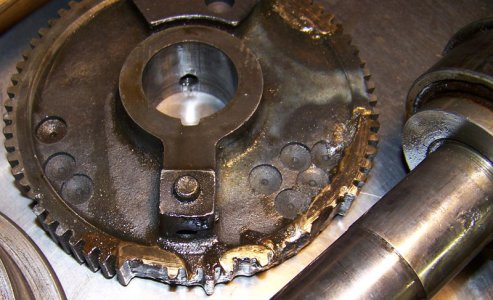Not to hijack the thread...
But to point out to FWG that we are all in the same boat out here, doing the same things, thinking the same thoughts with the same impulses. The difference between us is experience. Mine comes from elsewhere. Certainly not from machining. I don't know squat, but I'm having a lot of fun learning. Quite irregardless of the potential of the machine in question, the basic principles always apply, and arguably can best be learned on the simplest machine. I'm not even sure what all the controls do on my Prentice Gearhead yet, not that it is that complex... That century old beast is a rattlin, bangin, slip slidin SOB, but it is teaching me A LOT. The Logan is beautiful in its simplicity, and will hopefully become a much more civilized piece. At least I can get parts for it!
Yes, that is a many times hammered gear, for sure, shown here to illustrate what others are up against, and what can be overcome. It is the worst of four that had missing teeth on my poor old beast, all now replaced with used ones sourced from ebay. It seems that it might have lived at an armory or military training center, obviously being run by people that didn't necessarily know what they were doing. Yet, despite that severe usage - or perhaps BECAUSE of it - it has very little if any bed wear, and the parts that were not trashed are pretty decent.
So Guns, we all look forward to seeing what you find in your evaluation of what you've got there, and I think that's what you need to do. Step back and check it all out. Power them up an see how they work. You may have been a bit quick on the draw in buying what you did. First time that's ever happened in recorded history....

However, aside from money you may not have to toss around, the experience - the journey - is priceless!!
- - - Updated - - -
By the way...
Most of these old birds have been slathered with many layers of variously bilious or boring industrial colors over the years. Mine had 3! Like they say on ships, if it don't move PAINT IT, and they DID! If you study you will find that the hue of many original color lathes (which are fairly rare) varies widely. It seems to depend on usage and environment as to what shade they have become over the years. A very good approximation of the handsome original color (early lathes only) is
Benjamin Moore Baby Seal Grey 2119-30. That is what I am using, based on tips from restorers on other forums. It is not as blue as it appears in that previous photo. Good old alkyd enamel, probably like they had originally. Brush it on and then either stipple it with the brush or hit it with a roller lightly to get rid of the brush marks. Looks great!


